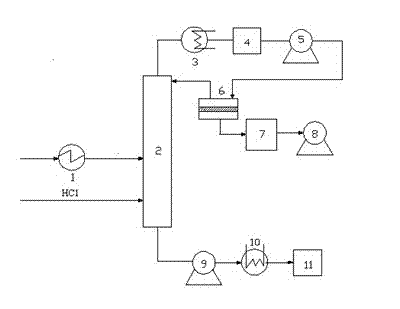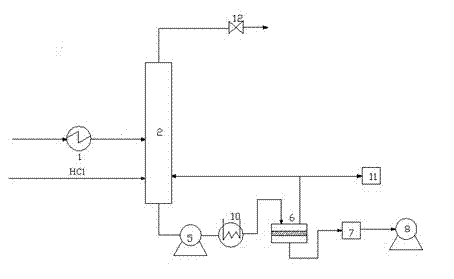Method for preparing dichloropropanol with chemical reaction-pervaporation coupling method
A technology of pervaporation and dichloropropanol, which is applied in organic chemistry, the introduction of halogen preparation, the separation/purification of hydroxyl compounds, etc., can solve the problems of inability to maximize the efficiency of chlorination reaction, energy loss, waste of resources, etc. Achieve low cost, reduce heat load, and save energy
- Summary
- Abstract
- Description
- Claims
- Application Information
AI Technical Summary
Problems solved by technology
Method used
Image
Examples
Embodiment 1
[0039] Example 1: A stirred tank reactor (produced by Jiangsu Gongtang Chemical Equipment Co., Ltd., K-type VN50, with a volume of 350L), glycerin was preheated and added to the reactor at a feed rate of 1.05kmol / h, and the reactor 9.2Kg catalyst (Rohm and Haas series Amberlyst 15 wet type, produced by Dow Chemical Company, treated with soaking water) was pre-loaded inside, and hydrogen chloride gas was fed from the bottom of the reactor at a feed rate of 2.5 kmol / h. The reaction is operated under normal pressure, and the reaction temperature is controlled at 110°C. After the steam at the top of the reactor is condensed, the liquid stream enters the inlet of the pervaporation device at a flow rate of 2.25 kmol / h, and the water vapor preferentially permeated on the downstream side of the pervaporation membrane is circulated. After the ethylene glycol is condensed, it flows out at 1.95 kmol / h, and the impermeable liquid on the upstream side of the membrane returns to the reactor ...
Embodiment 2
[0041] Example 2: Stirred tank reactor with a volume of 500 L, produced by Foshan Tesai Chemical Equipment Co., Ltd., model DJ35, glycerol is added to the reactor at a feed rate of 1.05 kmol / h after preheating, and the reactor is preheated. Load 6.5Kg catalyst (Rohm and Haas series Amberlyst 36 wet type, produced by Dow Chemical Company, treated by immersion water), and hydrogen chloride gas is added from the bottom of the reactor at a feed rate of 3.5 kmol / h. The operating pressure of the reaction is 3atm, the reaction temperature is controlled at 120°C, and the flow rate at the bottom of the reactor enters the inlet of the pervaporation device at a flow rate of 4.55 kmol / h. 2.02kmol / h flows out, and the impermeable liquid on the upstream side of the membrane returns to the reactor at a flow rate of 1.01kmol / h, and the other part is withdrawn as a product at a flow rate of 1.02kmol / h. The pervaporation membrane material is polyvinyl alcohol, and the membrane material is made ...
Embodiment 3
[0043] Embodiment 3: Stirred tank reactor, volume is 300L, produced by Foshan Tesai Chemical Equipment Co., Ltd., model DJ55, adds the glycerin and catalyst mixture after preheating (catalyst is acetic acid, Produced by Xuguang Chemical Co., Ltd., the amount used is 5% of the total amount of glycerin), and hydrogen chloride gas is fed from the bottom of the reactor at a feed rate of 1.5 kmol / h. The operating pressure of the reaction is 4atm, the reaction temperature is controlled at 140°C, and the flow rate at the bottom of the reactor enters the inlet of the pervaporation device at a flow rate of 1.95 kmol / h. A flow rate of 1.10 kmol / h flows out, a part of the impermeable liquid on the upstream side returns to the reactor at a flow rate of 0.35 kmol / h, and another part is withdrawn at a flow rate of 0.50 kmol / h. The pervaporation membrane material is polyvinyl alcohol, and the membrane material is made of polyvinyl alcohol GM-17s from Nippon Synthetic Chemical Industry Co., L...
PUM
 Login to View More
Login to View More Abstract
Description
Claims
Application Information
 Login to View More
Login to View More - R&D
- Intellectual Property
- Life Sciences
- Materials
- Tech Scout
- Unparalleled Data Quality
- Higher Quality Content
- 60% Fewer Hallucinations
Browse by: Latest US Patents, China's latest patents, Technical Efficacy Thesaurus, Application Domain, Technology Topic, Popular Technical Reports.
© 2025 PatSnap. All rights reserved.Legal|Privacy policy|Modern Slavery Act Transparency Statement|Sitemap|About US| Contact US: help@patsnap.com



